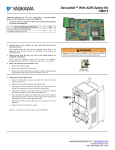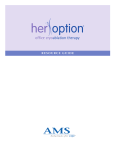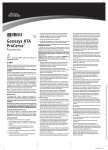Download GYNECARE THERMACHOICE® III Uterine Balloon
Transcript
GYNECARE THERMACHOICE® III Uterine Balloon Therapy System In-service Cynthia Pypcznski Paulette Gengenbacher September 2nd, 2015 Agenda • Overview • Steps for Use • Product Demonstration Video • Troubleshooting • Q&A • Enhanced Support Options • Wrap up 2 Overview 3 GYNECARE THERMACHOICE® III Uterine Balloon Therapy System A thermal balloon ablation device intended to ablate the endometrial lining of the uterus in premenopausal women with menorrhagia (excessive uterine bleeding) due to benign causes for whom childbearing is complete1 1. GYNECARE THERMACHOICE® III. Instructions for Use. 2010 Ethicon Inc. 4 Device Operation and Coverage • 160-180 mmHg and 87 °C (188 °F) applied to endometrial lining • Maintained temperature results in thermal ablation of endometrial tissue • Can conform to various shaped uteri 5 GYNECARE THERMACHOICE® III Uterine Balloon Therapy System • 1 sterile disposable balloon catheter and 30 cc syringe • 1 umbilical cable • 1 controller (with circulation port) • 1 power cord Medical Supplies • 50 cc sterile injectable plain 5% dextrose in water (D5W) • Sterile drape for umbilical cable (optional) • Uterine sound, cervical dilator(s) • Tenaculum (weighted) speculum Note: Use only plain D5W to inflate balloon catheter – never use any other fluid. 6 GYNECARE THERMACHOICE® III Uterine Balloon Therapy System 7 GYNECARE THERMACHOICE® III Uterine Balloon Therapy System 8 Steps for Use 9 Steps for Use Make all connections before turning controller power on or adding fluid. 1. Disinfect umbilical cable per Operating Manual. Drape umbilical cable with sterile drape if necessary. 10 Steps for Use Make all connections before turning controller power on or adding fluid. 2. Connect catheter pressure line to controller (Luer lock). Do not over tighten, but ensure it is fully connected. Handle balloon portion of catheter carefully to prevent damage. 11 Steps for Use Make all connections before turning controller power on or adding fluid. 3. Plug circulation catheter plug into controller circulation port. Avoid loops, kinks, or bends to reduce the potential of motor fault issues. 12 Setup 4. Connect umbilical cable to catheter (line up arrows on umbilical cable to notch/arrow on catheter’s cable receptacle). 13 Setup 5. Turn on controller power. 14 Catheter Priming and Pressure Titration Note: Pressure line MUST be connected to controller BEFORE balloon catheter is filled with fluid, or device will not function properly. 6. Fill syringe with up to 20 cc sterile D5W. Connect syringe to catheter. Do not over tighten, but ensure snug connection. Note: Use only plain D5W to inflate balloon catheter – never use any other fluid. 15 Catheter Priming and Pressure Titration Note: Pressure line MUST be connected to controller BEFORE balloon catheter is filled with fluid, or device will not function properly. 7. Prime catheter by pointing tip down, pressing trumpet valve, and filling SLOWLY with up to 20 cc D5W. Ensure balloon is fully deployed. When adding fluid during priming, ensure balloon fully opens so that no sides are touching. Then press valve to SLOWLY evacuate fluid and air from balloon to -150 to -200 mmHg as indicated by pressure display on controller. DO NOT EXCEED -200 mmHg negative pressure during evacuation. Excessive negative pressure can lead to greater pressure fluctuation during treatment. 16 Catheter Priming and Pressure Titration 8. Fill syringe to 30 cc with D5W, purge air, and connect to catheter (do not over tighten, but ensure snug connection). Up to 5 cc additional fluid may be used if needed, for a total of 35 cc. 17 Catheter Priming and Pressure Titration 9. Wet outside of balloon with D5W. 18 Catheter Priming and Pressure Titration 10. After sounding uterine depth and wetting balloon, SLOWLY INSERT BALLOON CATHETER into uterus until tip is touching fundus. Ensure that depth indicated by markings on catheter is consistent with previous sound measurement. Use tenaculum to hold the cervix if necessary. Ensure that the cervix is dilated to 5mm, and do not use excessive force during insertion, as such force can cause the balloon to tear or the catheter to perforate the uterine wall. 19 Catheter Priming and Pressure Titration 11. Fill balloon slowly to 160-180 mmHg pressure, using 2-35 cc D5W. Add fluid as necessary to titrate pressure. Do not use >35 cc. VERY IMPORTANT: Allow pressure to stabilize to 160-180 mmHg for a minimum of 30 seconds before pressing START button. Note: Activation pressure (minimum starting pressure) is ≥150 mmHg. 20 Treatment 12. After pressure has been stable above 150 mmHg for at least 10 seconds, green START button will flash, indicating procedure cycle can begin. Push START button on controller. Hold catheter immobile and centered during procedure. Note: Ensure balloon catheter is centered in uterus to minimize potential overheat error codes and catheter failure. 21 Treatment 13. Controller activates preheat cycle to heat fluid to 87°C. Preheating may take up to 4 minutes. Once 87°C is reached, an audible tone will indicate automatic activation of the 8-minute cycle. 22 Treatment 14. Controller automatically activates 8-minute therapy cycle. Note: Pressure may rise initially and then fall gradually during procedure. This is a normal reaction as uterus contracts then relaxes. 23 Treatment 15. Controller automatically terminates heating at end of therapy cycle. Total treatment time will be displayed on controller (preheat time + therapy time). 24 Post-Treatment 16. Wait 30 seconds for fluid to cool. Message displays when cool down is completed. 17. Remove all fluid from balloon. Remove and discard catheter. Retain umbilical cable and disinfect for next case. Following 20 uses, discard umbilical cable and replace. 25 For detailed instructional steps on the use of the GYNECARE THERMACHOICE® III Uterine Balloon Therapy System, please refer to the Instructions for Use or System Operating Manual. For all product details, including a complete list of warnings, precautions, adverse events, indications, and contraindications, please reference the Instructions for Use and System Operating Manual. Customer Support For product use assistance, clinical guidelines, service and repair, emergency assistance, or complaints, please contact our Customer Support Center at [email protected] or by calling 1-877-ETHICON (384-4266). Our Support Center is staffed 24 hours a day, 7 days a week by qualified nurses and biomedical technicians to answer your product-related questions. For any product issues, please file a complaint and return the disposable product without any additional field testing or tampering of product. 26 Product Demonstration Video 27 This demonstration is meant to complement the official Instructions for Use and Operating Manual, not to replace them. Before proceeding with the GYNECARE THERMACHOICE® III Uterine Balloon Therapy System procedure, please consult the GYNECARE THERMACHOICE III Uterine Balloon Therapy System Operating Manual. 28 29 Troubleshooting 30 Optimal Device Performance • Unable to maintain negative pressure during catheter priming – Trumpet valve must be released to maintain negative pressure – Make certain to fill catheter with balloon tip in down position – Negative pressure only needs to be maintained for a minimum of 10 seconds • Unable to achieve temperature – Typically occurs when >35 cc D5W used • Once cycle begins, pressure will vary • Unable to maintain pressure during catheter priming; balloon leaks – Check Luer lock and make sure pressure line is properly connected – Make sure to wet balloon with D5W solution prior to inserting in uterus • Unable to sustain positive pressure during titration – Confirm uterus is no larger than 10 cm – Ensure trumpet valve is released during titration Pressure Mitigation During Catheter Priming • You may need to purge air from syringe several times to attain desired negative pressure. You must release trumpet valve to maintain negative pressure. Air should be completely evacuated to optimize the function of the device • During priming, when catheter pressure is <-150 mmHg, the Message Display is “Prime Catheter <-150mmHg” • DO NOT EXCEED -200 mmHg negative pressure during evacuation Pressure Mitigation During Pressure Titration • When pressing trumpet valve on top of balloon catheter and filling balloon slowly to pressure of 160-180 mmHg using 2-35 cc of D5W, release the trumpet valve to allow the pressure to stabilize. Do not allow the pressure to exceed 200 mmHg during titration. Incrementally add small volumes to achieve a stable pressure (no fluctuations greater than ±10 mmHg) of 160-180 mmHg for a minimum of 30 seconds. The pressure of the balloon against the uterine wall often precipitates uterine contraction, thereby temporarily increasing the pressure reading • If pressure cannot be stabilized at 160-180 mmHg for 30-45 seconds with 35 cc of fluid, this may indicate uterine perforation. Remove the fluid and then remove the balloon catheter. If a balloon leak is present, replace the catheter and continue with the procedure. If no balloon leak is found, perform appropriate diagnostic measure to evaluate for perforation before proceeding. If perforation cannot be ruled out, abandon the procedure • Once the heater is activated, the pressure may initially rise 10-20 mmHg; the pressure may then drop slowly for the remainder of the procedure. The ending balloon pressure may be as low as approximately 100 mmHg, and is typically between 120-150 mmHg Pressure Mitigation • It is recommended that for very small uteri*, pressure titration should occur towards the lower end of the range (i.e., use a minimum amount of fluid to reach 160 mmHg. This will reduce the potential for increase of pressure during the thermal treatment that might result in overpressure and system shutdown) • Positioning the device in a false passage may allow the balloon to reach operating pressure with a small amount of fluid. This may be misinterpreted as being a small uterine cavity. Care should be taken to insure the device is properly positioned in the uterine cavity • Do not allow pressure to exceed 200 mmHg during titration • Optimal balloon volume depends on the potential volume of the uterine cavity and is typically 6-20 cc at >160 mmHg (at start) and may be as great as 35 cc. If pressure level cannot be reached with 35 cc of fluid, remove balloon catheter and check for uterine perforation and/or balloon catheter leak. Replace balloon catheter if necessary *Safety and effectiveness have not been established in patients with small uterine cavities (<2 cc in volume or uterine sound <6 cm) Pressure Mitigation During Treatment • Pressure may rise slightly with initial heating. It is common to then see the pressure fall gradually during procedure. If the pressure reaches 200 mmHg, an alarm will sound. If the pressure exceeds 210 mmHg for more than 2 seconds, the controller will terminate the procedure. The procedure may be restarted with a lower starting pressure to complete an 8-minute therapy • A rapid drop in pressure or a failure to maintain pressure may be the result of a catheter leak or uterine perforation. After sufficient cooling (of at least 30 seconds), remove the fluid and then remove the balloon catheter and abort the procedure. A work-up for perforation should be considered prior to discharge Q&A 36 Enhanced Support Options 37 Support Services • Live Customer Support • Training and Educational Resources • Product Information 38 Live Customer Support Contact Ethicon for Live Procedural Support, Equipment Troubleshooting or Repair, Emergency Assistance, or Product Ordering. Live Virtual Case Coverage • Schedule a representative to be available by phone for your procedure, call 877-ETHICON (384-4266) Option 3 or schedule by e-mail at [email protected] Equipment Troubleshooting and Repair • Calibration, repair, and loaners: call 877-ETHICON (384-4266) Option 3 Emergency Procedure Support and Troubleshooting • Available 24/7: 877-ETHICON (384-4266) Option 4 Chat Live • Available 7:30AM - 6:30PM EST Monday–Friday Product Ordering • To order GYNECARE THERMACHOICE® Uterine Balloon Therapy System or supplies, call 800-2552500 or www.jnjgateway.com Training and Educational Resources Videos and educational brochures are available on ethicon.com, including • In-service video • Procedure video • Patient brochures Available for office use from 877-ETHICON (384-4266) 40 Product Information Center Additional resources available on ethicon.com: • Product overview • Description & specifications • Sales aid • Brochures • Science & technology • Reimbursement guide • IFU • Latex information • User/service manual 41 Thank You © 2015 Ethicon US, LLC. All rights reserved. 039593-150901



















































